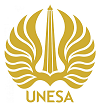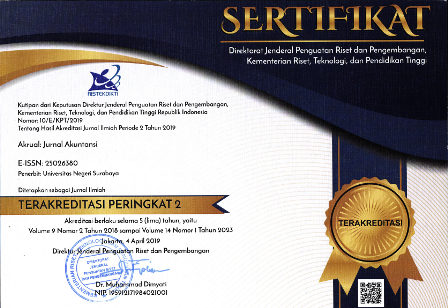The Indonesia's Financial Landscape: P2P Loan Growth, Bank Performance and The Covid-19 Connection
DOI:
https://doi.org/10.26740/jaj.v16n1.p105-120Keywords:
Banking credit; COVID-19; FinTech; Non-performing loan; Peer-to-Peer loanAbstract
Introduction/ Main Objectives: This study investigated the impact of peer-to-peer (P2P) loan growth on banking credit growth in Indonesia, specifically focusing on regions with low and high-risk non-performing loan (NPL) banking, both before and during the exogenous shock of the COVID-19 pandemic. Background Problems: The digitalization of the banking industry faces a new challenge caused by start-up companies taking advantage of financial technology (FinTech) to create a new business model and financial innovation that can create financial solutions for the community. Research Methods: The research employed a panel regression model using monthly data from 33 provinces in Indonesia. The data spans from July 2019 to March 2020, representing the period before the COVID-19 pandemic, and from July 2020 to March 2021, covering the pandemic period. Finding / Results: The regression analysis of data from the pre-COVID-19 periods revealed that the P2P loan growth negatively affects the banking credit growth in the provinces with low-risk banking NPLs; while on the contrary, during the COVID-19 pandemic, the P2P loan growth positively affects the banking credit growth in the provinces with high-risk banking NPL. Conclusion: The complementary impact of the P2P platform on banking occurred during the COVID-19 pandemic, but banks must remain vigilant because the P2P platform had become a substitute for banking prior to the COVID-19 pandemic. Therefore, when the COVID-19 pandemic passes and the stimulus from the financial services authority is no longer valid, there are still potentials for the P2P platform to substitute banks in Indonesia.
References
Aaker, D., & Keller, K. L. (1990). Consumer Evaluations of Brand Extensions. Journal of Marketing, 54(1), 27. https://doi.org/10.2307/1252171
Aysan, A. F., & Disli, M. (2019). Small business lending and credit risk: Granger causality evidence. Economic Modelling, 83(October 2017), 245–255. https://doi.org/10.1016/j.econmod.2019.02.014
Baltagi, B. H. (2015). The Oxford Handbook of Panel Data. Oxford University Press.
Beatty, A., Liao, S., & Zhang, H. (Helen). (2019). The effect of banks’ financial reporting on syndicated-loan structures. Journal of Accounting and Economics, 67(2–3), 496–520. https://doi.org/10.1016/j.jacceco.2019.01.002
Berndt, A., & Gupta, A. (2009). Moral hazard and adverse selection in the originate-to-distribute model of bank credit. Journal of Monetary Economics, 56(5), 725–743. https://doi.org/10.1016/j.jmoneco.2009.04.002
Brown, R. S., & Kline, W. A. (2020). Exogenous shocks and managerial preparedness: A study of U.S. airlines’ environmental scanning before the onset of the COVID-19 pandemic. Journal of Air Transport Management, 89(June), 1–9. https://doi.org/10.1016/j.jairtraman.2020.101899
Chandler, J. A., Short, J. C., & Wolfe, M. T. (2021). Finding the crowd after exogenous shocks: Exploring the future of crowdfunding. Journal of Business Venturing Insights, 15(March), 1–6. https://doi.org/10.1016/j.jbvi.2021.e00245
Chauhan, Y., & Kumar, S. B. (2019). Does accounting comparability alleviate the informational disadvantage of foreign investors ? International Review of Economics and Finance, 60(December 2018), 114–129. https://doi.org/10.1016/j.iref.2018.12.018
Dang, V. D. (2019). The effects of loan growth on bank performance: Evidence from Vietnam. Management Science Letters, 9, 899–910. https://doi.org/10.5267/j.msl.2019.2.012
Das, P. (2019). Econometrics in Theory and Practice. In Econometrics in Theory and Practice. Springer Nature Singapore Pte Ltd. https://doi.org/10.1007/978-981-32-9019-8
Doan, T., Nguyen, S., Vu, H., Tran, T., & Lim, S. (2015). Does rising import competition harm local firm productivity in less advanced economies ? Evidence from the Vietnam ’s manufacturing sector. The Journal of International Trade & Economic Development, May, 37–41. https://doi.org/10.1080/09638199.2015.1035739
Doern, R., Williams, N., & Vorley, T. (2019). Special issue on entrepreneurship and crises: business as usual? An introduction and review of the literature. Entrepreneurship and Regional Development, 31(5–6), 400–412. https://doi.org/10.1080/08985626.2018.1541590
Fu, J., & Mishra, M. (2022). Fintech in the time of COVID-19: Technological adoption during crises. Journal of Financial Intermediation, 50, 1–30. https://doi.org/10.1016/j.jfi.2021.100945
Gomber, P., Koch, J.-A., & Siering, M. (2017). Digital Finance and FinTech: current research and future research directions. Journal of Business Economics, 87(5), 537–580. https://doi.org/10.1007/s11573-017-0852-x
Goodell, J. W. (2020). COVID-19 and finance: Agendas for future research. Finance Research Letters, 35(April). https://doi.org/10.1016/j.frl.2020.101512
Gupta, A., & Xia, C. (2018). A Paradigm Shift in Banking: Unfolding Asia’s FinTech Adventures. In Banking and Finance Issues in Emerging Markets (pp. 215–254). Emerald Publishing Limited. https://doi.org/10.1108/S1571-038620180000025010
Hasan, R., Ashfaq, M., & Shao, L. (2021). Evaluating Drivers of Fintech Adoption in the Netherlands. Global Business Review, 1–14. https://doi.org/10.1177/09721509211027402
Hoechle, D. (2007). Robust standard errors for panel regressions with cross-sectional dependence. Stata Journal, 7(3), 281–312. https://doi.org/10.1177/1536867x0700700301
Ivanovi, M. (2016). Determinants of Credit Growth : The Case of Montenegro. Journal of Central Banking Theory and Practice, 2, 101–118. https://doi.org/10.1515/jcbtp-2016-0013
Jagtiani, J., & Lemieux, C. (2018). Do fintech lenders penetrate areas that are underserved by traditional banks ? Journal of Economics and Business, 100(March), 43–54. https://doi.org/10.1016/j.jeconbus.2018.03.001
Jiang, C., Xu, Q., Zhang, W., Li, M., & Yang, S. (2018). Does automatic bidding mechanism affect herding behavior ? Evidence from online P2P lending in China. Journal of Behavioral and Experimental Finance, 20, 39–44. https://doi.org/10.1016/j.jbef.2018.07.001
Jin, J. Y., Kanagaretnam, K., Liu, Y., & Liu, N. (2019). Banks’ loan growth, loan quality, and social capital. Journal of Behavioral and Experimental Finance, 21, 83–102. https://doi.org/10.1016/j.jbef.2018.11.004
Kohardinata, C., Soewarno, N., & Tjahjadi, B. (2020). Indonesian peer to peer lending (P2P) at entrant’s disruptive trajectory. Business: Theory and Practice, 21(1), 104–114. https://doi.org/10.3846/btp.2020.11171
Kohardinata, C., Suhardianto, N., & Tjahjadi, B. (2020). Peer-to-peer lending platform: From substitution to complementary for rural banks. Business: Theory and Practice, 21(2), 713–722. https://doi.org/10.3846/btp.2020.12606
Kozarić, K., & Delihodić, E. Z. (2020). Effects of Macroeconomic Environment on Non-Performing Loans and Financial Stability: Case of Bosnia and Herzegovina. Journal of Central Banking Theory and Practice, 9(2), 5–17. https://doi.org/10.2478/jcbtp-2020-0011
Kuckertz, A., Brändle, L., Gaudig, A., Hinderer, S., Morales Reyes, C. A., Prochotta, A., Steinbrink, K. M., & Berger, E. S. C. (2020). Startups in times of crisis – A rapid response to the COVID-19 pandemic. Journal of Business Venturing Insights, 13(April). https://doi.org/10.1016/j.jbvi.2020.e00169
Lavryk, A. (2016). P2P lending as an alternative to bank lending in Ukraine. Banks and Bank Systems, 11(4), 20–30. https://doi.org/10.21511/bbs.11(4).2016.02
Levin, J., & Milgrom, P. (2004). Consumer theory. https://web.stanford.edu/~jdlevin/Econ 202/Consumer Theory.pdf
Liu, J., Li, X., & Wang, S. (2020). What have we learnt from 10 years of fintech research? a scientometric analysis. Technological Forecasting and Social Change, 155(March), 1–12. https://doi.org/10.1016/j.techfore.2020.120022
Lu, D., Thangavelu, S. M., & Hu, Q. (2005). Biased lending and non-performing loans in China’s banking sector. Journal of Development Studies, 41(6), 1071–1091. https://doi.org/10.1080/00220380500155361
Ma, L., Zhao, X., Zhou, Z., & Liu, Y. (2018). A new aspect on P2P online lending default prediction using meta-level phone usage data in China. Decision Support Systems, 111(November 2017), 60–71. https://doi.org/10.1016/j.dss.2018.05.001
Miyajima, K. (2020). What Influences Bank Lending in Saudi Arabia? Islamic Economic Studies, 27(2), 125–155. https://doi.org/10.1108/IES-07-2019-0018
Nguyen, T. Le, Vu Van, H., Nguyen, L. D., & Tran, T. Q. (2017). Does rising import competition harm Vietnam’s local firm employment of the 2000s? Economic Research, 30(1), 1882–1895. https://doi.org/10.1080/1331677X.2017.1392883
Okuyan, H. A. (2014). The effect of asymmetric information on turkish banking sector and credit markets. Revue Economique, 65(5), 699–708. https://doi.org/10.3917/reco.655.0699
Otoritas Jasa Keuangan. (2020). Perkembangan Fintech Lending Desember 2020. In Otorisasi Jasa Keuangan. https://www.ojk.go.id/id/kanal/iknb/data-dan-statistik/fintech/Pages/-Statistik-Fintech-Lending-Periode-Desember-2020.aspx
Phan, D. H. B., Narayan, P. K., Rahman, R. E., & Hutabarat, A. R. (2019). Do financial technology firms influence bank performance? Pacific-Basin Finance Journal, November 2, 1–13. https://doi.org/10.1016/j.pacfin.2019.101210
Shawtari, F. A. M. (2018). Ownership type, bank models, and bank performance: the case of the Yemeni banking sector. International Journal of Productivity and Performance Management, 67(8), 1271–1289. https://doi.org/10.1108/IJPPM-01-2018-0029
Soluk, J., Kammerlander, N., & De Massis, A. (2021). Exogenous shocks and the adaptive capacity of family firms: exploring behavioral changes and digital technologies in the COVID-19 pandemic. R and D Management, 51(4), 364–380. https://doi.org/10.1111/radm.12471
Stern, C., Makinen, M., & Qian, Z. (2017). FinTechs in China – with a special focus on peer to peer lending. Journal of Chinese Economic and Foreign Trade Studies, 10(3), 215–228. https://doi.org/10.1108/JCEFTS-06-2017-0015
Tang, H. (2019). Peer-to-Peer Lenders Versus Banks: Substitutes or Complements? Review of Financial Studies, 32(5), 1900–1938. https://doi.org/10.1093/rfs/hhy137
Thakor, A. V. (2020). Fintech and banking : What do we know ? Journal of Financial Intermediation, 41, 1–13. https://doi.org/10.1016/j.jfi.2019.100833
The Federal Reserve Bank of Dallas. (2020). Growth Rates Versus Levels. https://www.dallasfed.org/research/basics/growth.aspx
Thomas, R., & Singh Thakur, S. (2020). Non-performing Loans and Moral Hazard in the Indian Banking Sector: A Threshold Panel Regression Approach. Global Business Review, 1–18. https://doi.org/10.1177/0972150920926135
Umar, M., & Sun, G. (2016). Non-performing loans ( NPLs ), liquidity creation , and moral hazard : Case of Chinese banks. China Finance and Economic Review, 4(10), 1–23. https://doi.org/10.1186/s40589-016-0034-y
Zalan, T., & Toufaily, E. (2017). The promise of fintech in emerging markets: Not as disruptive. Contemporary Economics, 11(4), 415–430. https://doi.org/10.5709/ce.1897-9254.253
Zhang, D., Cai, J., Dickinson, D., & Kutan, A. (2016). Non-performing loans, moral hazard and regulation of the Chinese commercial banking system. Journal of Banking and Finance, 63, 48–60. https://doi.org/10.1016/j.jbankfin.2015.11.010
Zhang, Z., Hu, W., & Chang, T. (2019). Nonlinear effects of P2P lending on bank loans in a Panel Smooth Transition Regression model. International Review of Economics and Finance, 59(August 2017), 468–473. https://doi.org/10.1016/j.iref.2018.10.010
Zunić, A., Kozarić, K., & Dzelihodzić, E. Z. (2021). Non-Performing Loan Determinants and Impact of COVID-19: Case of Bosnia and Herzegovina. Journal of Central Banking Theory and Practice, 10(3), 5–22. https://doi.org/10.2478/jcbtp-2021-0021
Downloads
Published
How to Cite
Issue
Section
License
Copyright (c) 2024 Cliff Kohardinata, Novrys Suhardianto, Bambang Tjahjadi, Luky Patricia Widianingsih

This work is licensed under a Creative Commons Attribution-NonCommercial 4.0 International License.
 Abstract views: 468
,
Abstract views: 468
, PDF Downloads: 425
PDF Downloads: 425

















